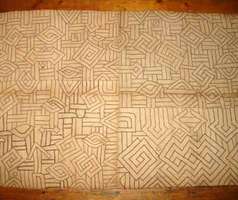|
Tribal African textiles are as diverse as the people who create them.
When it comes to making and decorating tribal African textiles, the techniques used range from simple to complex. They can be woven in patterns, dyed in different colors or brocades can be added. Another way to decorate fabrics is through the use of dyes. Cotton is the material of choice and the most common dye used is indigo. Women gather the leaves of a plant called tinto, they crush them, roll the pulp into balls and leave them in the sun to dry. The dried balls are then mixed with water and ash to create the dye. This process is still being used in Ghana and other parts of Africa. Another technique used in creating tribal African textiles is the resist method of dyeing. This consists of drawing the desired pattern or motif on the cloth with an impermeable material. After being dipped in the dye, the drawn pattern will appear in the original color of the fabric. The Yoruba people of Nigeria use this technique to create adire fabrics. The Bambara of Mali produced bokolanfini fabrics. The methods used were very complex and time consuming. The designs were made with yellow pigments and mud baths and required multiple soakings in dye and also a lot of rinsing. Men usually wore clothing made out of these fabrics to go hunting. Embroidery is another way of decorating tribal African fabrics. Finely embroidered clothing is used among the islamic tribes such as the Hausa, the Peul and the Nupe of northern Nigeria. The men usually wear elaborately embroidered boubous. When it comes to textiles, Africa has a variety that is as diverse as the tribes who make and use them.
|

